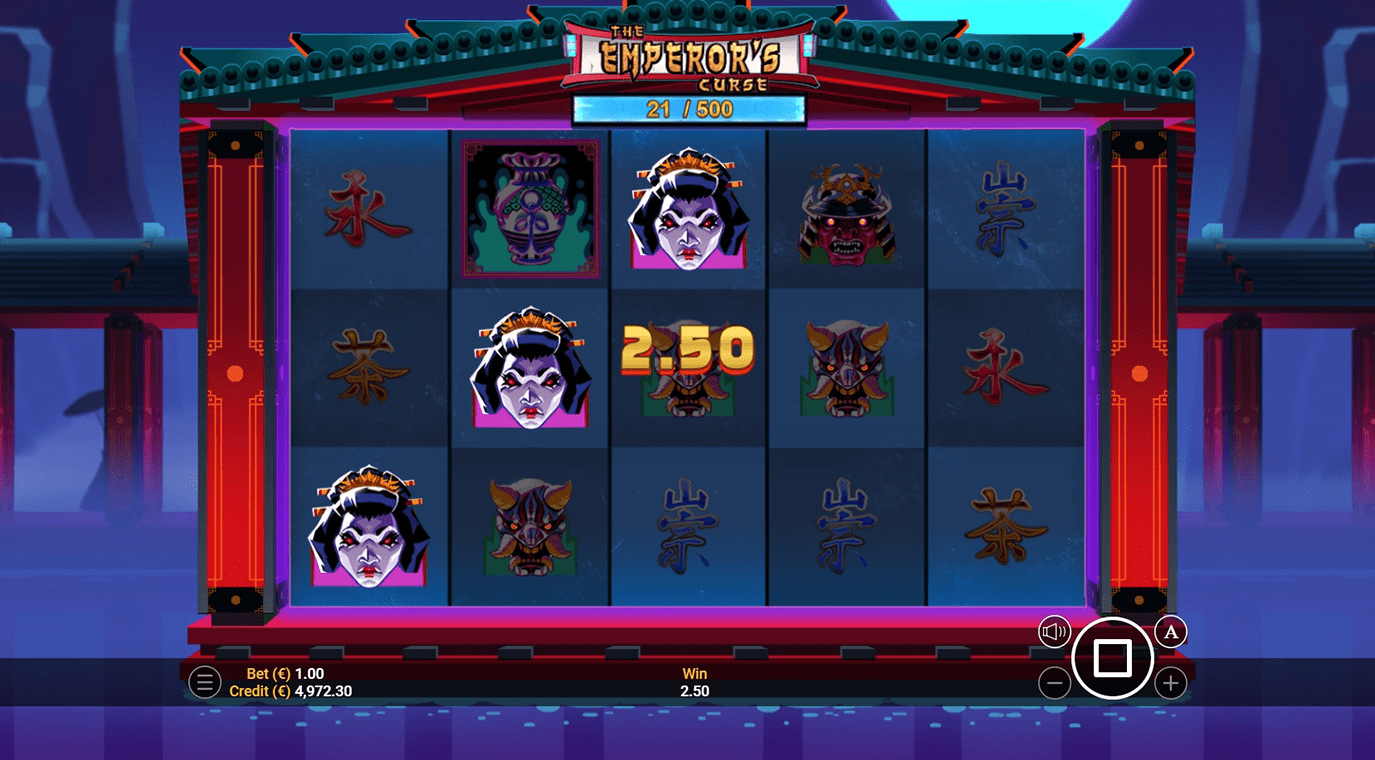EXPLORE POKIE MACHINES
Deposit Bonus
Free Spins
 Great selection of pokies
Great selection of pokies  Mystery Drops prizes
Mystery Drops prizes  High limits for VIP’s
High limits for VIP’s .svg)
Supplier

Reels

Rows

Paylines
.svg)
Released

RTP

Max Win

Volatility

Theme

Multipliers

Bonus Buy

Progressive
You already know by now that The Emperor’s Curse features an immersive storyline. However, it’s important to see what happens once the reels start spinning.
The first thing you’ll see after the pokie loads is the captivating scenery. The night has fallen on the imperial palace, with only the full moon illuminating its dark corridors. The only figure you’ll see is Alita, slowly pacing up and down, as if she’s aware of the tragedy that had taken place.
The graphical quality is impressive, and the top-notch animation only further enhances the visual experience. Some may argue that the soundtrack is too generic, but it perfectly fits the theme.
Moving on to the paytable, where we find a total of 8 regular symbols. Instead of traditional playing cards, the developers used Chinese letters as the lows, with premiums featuring a beautiful design inspired by the story, whose appearance will send shivers down your spine.
Like premiums, the Wild and the Scatter symbols are masterpieces, boasting eye-catching details and colourful designs.
The Emperor’s Curse uses a standard grid layout, meaning you’ll find 5 reels and 3 rows in play, together with 20 fixed paylines. Only regular symbols pay, with at least 3 matching icons, needed to award a payout.
Speaking of payouts, lows provide rewards from 2.5x to 3x the bet for 5-of-a-kind wins, while premiums offer rewards ranging from 7.5x to 25x the stake for the same number of symbols in a winning combination.
The RTP is 96.00%, while medium high volatility promises valuable wins and rather high win frequency, at least in theory. A stake of $0.10 sets reels in motion, while the maximum bet is $20 per spin. The top payout is worth 2,000x the bet.
The Emperor’s Curse is undoubtedly a visually impressive pokie. However, more is needed to keep the players engaged, which is precisely why we’ll explore its extras.
Wilds can appear anywhere on the reels, doing their usual job of replacing other regulars. In The Emperor’s Curse, they have an additional role. Wilds award respins, and during respins, they can add more of them to the tally.
There are two ways to get to the Free Spins feature. The easier one involves landing at least 3 Scatter symbols anywhere across the grid. Depending on the number of the triggering symbols, you’ll get 8, 12, or 15 spins.
From my experience, getting there can take some time, and, at moments, it was a bit frustrating. Also, I’m used to seeing animation when Free Spins are triggered, a change in the background imagery, or something else that shows a bonus round has been activated, but you won’t find anything like that in The Emperor’s Curse.
Once the Free Spins feature starts, Wild will continue to award respins, with one crucial difference compared to the base game. Upon landing, they will expand the entire reel.
Now, let’s talk about the second way you can gain access to Free Spins, the harder one. Above the reels, you’ll find the Imperial Counter, filled whenever a Scatter appears on the grid. Fill it all the way to trigger what’s nominally called the Imperial Bonus. When activated like this, the round will consist of 10 freebies with a 4x multiplier and up to 5 Wild Reels.
















In most parts, ZeusPlay has done a great job with The Emperor’s Curse. The pokie looks superb, with stunning visuals and colourful yet dark imagery adding to the game’s horror story. Aside from the looks, there are plenty of other positive things.
Wilds appearing in the base not only substitute for other symbols but also trigger respins. Wilds are omnipotent in this release, as they can also expand, at least during Free Spins.
Speaking about Free Spins, you nominally have 2 different features, although they are simply different flavours of a regular Free Spins round.
However, I felt there was something missing, at least at moments. Honestly, an extra feature could have added to the depth. Another downfall is the top payout of just 2,000x. I expected a more suitable award for the medium high maths model.
Pros
 Wilds trigger respins
Wilds trigger respins 2 Free Spins rounds
2 Free Spins rounds Expanding Wilds
Expanding Wilds Multipliers
MultipliersCons
 Lacks features
Lacks features Low maximum payout
Low maximum payout